See Page 1 |
2 |
3 |
4 | of the March 2024 homepage archives. Friday the 29th
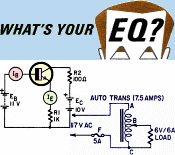 These two
circuit analysis challenges from the March 1967 issue of Radio−Electronics
magazine were simple enough that even I figured them out on the first try. The first
one requires simply summing currents given the stated resistor and voltage values.
For the second problem, note the configuration is that of an autotransformer, then
used the provided load current and voltage to work it out based on power out versus
power in. That should make it a cinch for anyone else, too. I'm glad there was no
"black box" type problem in this set, since those take too much thinking, and my
solutions rarely match the author's. Bon chance... These two
circuit analysis challenges from the March 1967 issue of Radio−Electronics
magazine were simple enough that even I figured them out on the first try. The first
one requires simply summing currents given the stated resistor and voltage values.
For the second problem, note the configuration is that of an autotransformer, then
used the provided load current and voltage to work it out based on power out versus
power in. That should make it a cinch for anyone else, too. I'm glad there was no
"black box" type problem in this set, since those take too much thinking, and my
solutions rarely match the author's. Bon chance...
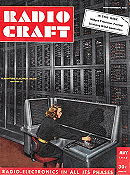 This Radio-Craft magazine article
starts out stating, "A skilled mathematician with a desk calculator requires four
years to do what the IBM Calculator does in eight hours." That was in 1948. A recent
headline read, "Given the task of finding a pattern in a seemingly random series
of numbers, Google's quantum computer produced an answer in 3 minutes and 20 seconds.
It estimates that the Summit supercomputer here at the Oak Ridge National Laboratory
in Tennessee would take 10,000 years to complete the task. The IBM 12,000 vacuum
tube computer performed its calculation for an improvement factor of [(3 yr
• 8760 hr/yr) + (1 yr • 8784 hr/yr)] ÷ 8 hr = 4383 (4.383
thousand). The Google quantum computer performed its calculation for an improvement
factor of (10,000 yr • 31557600 s/yr) ÷ 200 s = 3.15776E11 s
÷ 200 s = 1.57788E9 (1.57788 billion -- or milliard). The IBM computer
occupied nearly 50,000 square feet. Google's computer occupies about 50 square feet.
That's quite an evolution in computing power in seven decades... This Radio-Craft magazine article
starts out stating, "A skilled mathematician with a desk calculator requires four
years to do what the IBM Calculator does in eight hours." That was in 1948. A recent
headline read, "Given the task of finding a pattern in a seemingly random series
of numbers, Google's quantum computer produced an answer in 3 minutes and 20 seconds.
It estimates that the Summit supercomputer here at the Oak Ridge National Laboratory
in Tennessee would take 10,000 years to complete the task. The IBM 12,000 vacuum
tube computer performed its calculation for an improvement factor of [(3 yr
• 8760 hr/yr) + (1 yr • 8784 hr/yr)] ÷ 8 hr = 4383 (4.383
thousand). The Google quantum computer performed its calculation for an improvement
factor of (10,000 yr • 31557600 s/yr) ÷ 200 s = 3.15776E11 s
÷ 200 s = 1.57788E9 (1.57788 billion -- or milliard). The IBM computer
occupied nearly 50,000 square feet. Google's computer occupies about 50 square feet.
That's quite an evolution in computing power in seven decades...
 "Binghamton University Professor Seokheun
Choi sought to investigate his ideas about
integrated papertronics. A new research paper published in Advanced Sustainable
Systems reports his latest findings - and they could revolutionize how we monitor
the world around us. 'The biggest problem with paper for electronics is that the
paper is highly porous and rough,' said Choi, a faculty member in the Thomas J.
Watson College of Engineering and Applied Science's Department of Electrical and
Computer Engineering. 'These properties are very helpful for paperfluidics, because
those devices require high surface area and roughness - but for electronics, they
pose a critical challenge.' To mitigate some of those issues, most previous papertronics
have used laminated paper with electronic components affixed to them. That method
maintains the flexibility that paper has but does not fully utilize what the material
offers. Choi worked with Ph.D. students Zahra Rafiee and Anwar Elhadad as part of
the Bioelectronics and Microsystems Laboratory to develop a solution that takes
advantage of paper's attributes, combining functional inks, the capillary action..." "Binghamton University Professor Seokheun
Choi sought to investigate his ideas about
integrated papertronics. A new research paper published in Advanced Sustainable
Systems reports his latest findings - and they could revolutionize how we monitor
the world around us. 'The biggest problem with paper for electronics is that the
paper is highly porous and rough,' said Choi, a faculty member in the Thomas J.
Watson College of Engineering and Applied Science's Department of Electrical and
Computer Engineering. 'These properties are very helpful for paperfluidics, because
those devices require high surface area and roughness - but for electronics, they
pose a critical challenge.' To mitigate some of those issues, most previous papertronics
have used laminated paper with electronic components affixed to them. That method
maintains the flexibility that paper has but does not fully utilize what the material
offers. Choi worked with Ph.D. students Zahra Rafiee and Anwar Elhadad as part of
the Bioelectronics and Microsystems Laboratory to develop a solution that takes
advantage of paper's attributes, combining functional inks, the capillary action..."
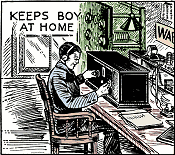 From keeping your son off the streets and
out of pool rooms to learning the use of his hands and mind for designing, building,
and operating radio, John T. Frye, later of "Carl & Jerry" authorship fame
in Popular Electronics magazine, offers no less than eight good reasons why a man
should encourage his son (and/or daughter) to
take up amateur radio as a hobby - preferably one that will last a lifetime.
As is true with any activity that requires a person to exercise hand-eye coordination
and think logically about the order and method for best accomplishing a task, Ham
radio offers the complete gambit of life skills that should be nurtured at an early
age. In the same manner a musician benefits mightily from learning to read and play
music while the brain is still in the process of wiring itself with specific neural
connections that make certain tasks more natural, a kid who learns to build, finish,
adjust, and operate electronics or model airplanes, or to perform acrobatics, sports,
and similar activities will possess a significant advantage over the vast majority
of people who decide later in life to adopt that activity... From keeping your son off the streets and
out of pool rooms to learning the use of his hands and mind for designing, building,
and operating radio, John T. Frye, later of "Carl & Jerry" authorship fame
in Popular Electronics magazine, offers no less than eight good reasons why a man
should encourage his son (and/or daughter) to
take up amateur radio as a hobby - preferably one that will last a lifetime.
As is true with any activity that requires a person to exercise hand-eye coordination
and think logically about the order and method for best accomplishing a task, Ham
radio offers the complete gambit of life skills that should be nurtured at an early
age. In the same manner a musician benefits mightily from learning to read and play
music while the brain is still in the process of wiring itself with specific neural
connections that make certain tasks more natural, a kid who learns to build, finish,
adjust, and operate electronics or model airplanes, or to perform acrobatics, sports,
and similar activities will possess a significant advantage over the vast majority
of people who decide later in life to adopt that activity...
 One aspect of advertising on the RF Cafe
website I have not covered is using
Google AdSense.
The reason is that I never took the time to explore how - or even whether it is
possible - to target a specific website for displaying your banner ads. A couple
display opportunities have always been provided for Google Ads to display, but the
vast majority of advertising on RF Cafe is done via private advertisers. That is,
companies deal with me directly and I handle inserting their banner ads into the
html page code that randomly selects and displays them. My advertising scheme is
what the industry refers to as a "Tenancy Campaign," whereby a flat price per month
is paid regardless of number of impressions or clicks. It is the simplest format
and has seemed to work well for many companies. With nearly 4 million pageviews
per year for RFCafe.com, the average impression rate per banner ad is about 280k
per year (in eight locations on each page, with >17k pages)... One aspect of advertising on the RF Cafe
website I have not covered is using
Google AdSense.
The reason is that I never took the time to explore how - or even whether it is
possible - to target a specific website for displaying your banner ads. A couple
display opportunities have always been provided for Google Ads to display, but the
vast majority of advertising on RF Cafe is done via private advertisers. That is,
companies deal with me directly and I handle inserting their banner ads into the
html page code that randomly selects and displays them. My advertising scheme is
what the industry refers to as a "Tenancy Campaign," whereby a flat price per month
is paid regardless of number of impressions or clicks. It is the simplest format
and has seemed to work well for many companies. With nearly 4 million pageviews
per year for RFCafe.com, the average impression rate per banner ad is about 280k
per year (in eight locations on each page, with >17k pages)...
Thursday the 28th
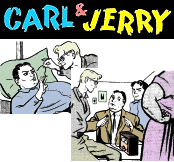 In this episode of John T. Frye's
Carl & Jerry technodrama series, titled "Lie
Detector Tells All," Carl Bishop has designed a crude lie detector using
a vacuum tube voltmeter (VTVM) to measure the change in resistance of the human
body when situations of stress and/or duress cause perspiration, which affects the
resistance to current flow. A VTVM was required because its high input impedance
(a few megohms) was necessary to accurately measure body resistance. In contrast,
a standard electromechanical meter movement (aka D'Arsonval) only provides a few
ohm of resistance. When this appeared in a 1955 issue of Popular Science
magazine, a VTVM was much more expensive than the D'Arsonval-based meter. Even a
low-end modern multimeter uses a field effect transistor (FET) - of the junction
(JFET) or metal oxide (MOSFET) type - with an input impedance in the tens to hundreds
of ohms. The story takes a comical turn when Jerry's parents volunteer (reluctantly)
to be test subjects for the invention. Interestingly, the Wikipedia entry for the
polygraph refers to it as "junk science," while noting that many countries' law
enforcement agencies use it to some degree... In this episode of John T. Frye's
Carl & Jerry technodrama series, titled "Lie
Detector Tells All," Carl Bishop has designed a crude lie detector using
a vacuum tube voltmeter (VTVM) to measure the change in resistance of the human
body when situations of stress and/or duress cause perspiration, which affects the
resistance to current flow. A VTVM was required because its high input impedance
(a few megohms) was necessary to accurately measure body resistance. In contrast,
a standard electromechanical meter movement (aka D'Arsonval) only provides a few
ohm of resistance. When this appeared in a 1955 issue of Popular Science
magazine, a VTVM was much more expensive than the D'Arsonval-based meter. Even a
low-end modern multimeter uses a field effect transistor (FET) - of the junction
(JFET) or metal oxide (MOSFET) type - with an input impedance in the tens to hundreds
of ohms. The story takes a comical turn when Jerry's parents volunteer (reluctantly)
to be test subjects for the invention. Interestingly, the Wikipedia entry for the
polygraph refers to it as "junk science," while noting that many countries' law
enforcement agencies use it to some degree...
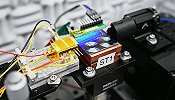 "Researchers from the US National Institute
of Standards and Technology (NIST), the University of Colorado Boulder, the NASA
Jet Propulsion Laboratory, the California Institute of Technology, the University
of California Santa Barbara, the University of Virginia and Yale University have
developed a
chip that converts light into microwaves. The chips reduce timing jitter to
15 femtoseconds making the signals more stable and precise in ways that could increase
radar sensitivity, the accuracy of ADCs and the clarity of astronomical images captured
by groups of telescopes. Researchers have taken what was once a tabletop-size system
and shrunk much of it into a chip, about the same size as a digital camera memory
card. Reducing timing jitter on a small scale reduces power usage and makes it more
usable in everyday devices. Right now, several of the components for this technology..." "Researchers from the US National Institute
of Standards and Technology (NIST), the University of Colorado Boulder, the NASA
Jet Propulsion Laboratory, the California Institute of Technology, the University
of California Santa Barbara, the University of Virginia and Yale University have
developed a
chip that converts light into microwaves. The chips reduce timing jitter to
15 femtoseconds making the signals more stable and precise in ways that could increase
radar sensitivity, the accuracy of ADCs and the clarity of astronomical images captured
by groups of telescopes. Researchers have taken what was once a tabletop-size system
and shrunk much of it into a chip, about the same size as a digital camera memory
card. Reducing timing jitter on a small scale reduces power usage and makes it more
usable in everyday devices. Right now, several of the components for this technology..."
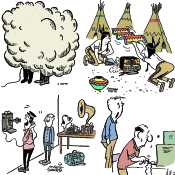 It's time for a few more
electronics-themed comics. This set from four different artists comes from the
September 1967 issue of Popular Electronics magazine. Users of modern,
solid state radio gear are not familiar with the kinds of problems that plagued
the older vacuum tube equipment - mainly overheating and a tendency for that smoke
that is supposed to remain inside resistors and capacitors leaking out and breaking
the set. One good thing about the overheated components that help with troubleshooting
is that the designers at the factory added a chemical to give off the unique burnt
resistor or capacitor odor that let you sniff out the faulty part; you know, kind
of like the odor added to natural gas (which itself is odorless) to alert you to
a leak. Be sure to use one or more of these in the opening slides of your next presentation
for putting your audience in a good mood. I colorized the comics, so blame me for
weird choices... It's time for a few more
electronics-themed comics. This set from four different artists comes from the
September 1967 issue of Popular Electronics magazine. Users of modern,
solid state radio gear are not familiar with the kinds of problems that plagued
the older vacuum tube equipment - mainly overheating and a tendency for that smoke
that is supposed to remain inside resistors and capacitors leaking out and breaking
the set. One good thing about the overheated components that help with troubleshooting
is that the designers at the factory added a chemical to give off the unique burnt
resistor or capacitor odor that let you sniff out the faulty part; you know, kind
of like the odor added to natural gas (which itself is odorless) to alert you to
a leak. Be sure to use one or more of these in the opening slides of your next presentation
for putting your audience in a good mood. I colorized the comics, so blame me for
weird choices...
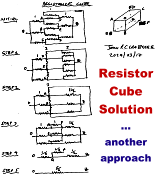 Probably the most responded-to article I
have ever written is the "The
Resistor Cube Equivalent Resistance Conundrum," aka Kirt's Cogitations™ #256.
Having equal resistances in all branches usually makes things easier. An alternate
method of solution, posted here, was provided by RF Cafe visitor Les Carpenter.
A couple days ago, another approach to the solution was submitted by Mr. John
Crabtree. As with the others, his work demonstrates an intuitive way of looking
at the circuit that simplifies a solution. Whereas my method invoked knowledge of
currents into and out of nodes, then dividing that current into a voltage applied
across two opposing corners, John combines parallel and series resistances until
a final single equivalent resistance emerges. I like his old school pencil and paper
presentation rather than a computer drawing. It reminds me of the days when teachers
wrote on a transparency on an overhead projector (while students frantically tried
to copy it down and comprehend what is being discussed at the same time)... Probably the most responded-to article I
have ever written is the "The
Resistor Cube Equivalent Resistance Conundrum," aka Kirt's Cogitations™ #256.
Having equal resistances in all branches usually makes things easier. An alternate
method of solution, posted here, was provided by RF Cafe visitor Les Carpenter.
A couple days ago, another approach to the solution was submitted by Mr. John
Crabtree. As with the others, his work demonstrates an intuitive way of looking
at the circuit that simplifies a solution. Whereas my method invoked knowledge of
currents into and out of nodes, then dividing that current into a voltage applied
across two opposing corners, John combines parallel and series resistances until
a final single equivalent resistance emerges. I like his old school pencil and paper
presentation rather than a computer drawing. It reminds me of the days when teachers
wrote on a transparency on an overhead projector (while students frantically tried
to copy it down and comprehend what is being discussed at the same time)...
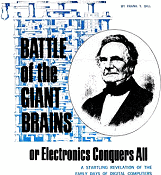 Albert Einstein declared and proved that
time is relative and depends on the observer's perspective. To someone sixty years
old, the year 1971 seems like it was just yesterday, but to people born a couple
decades ago, it seems like ancient history. Even so, I am taken by surprise when
I read a story from a 1971 issue of Popular Electronics magazine that has
produced a list of "early
computers" and it includes models like the ENIAC and Harvard Mark I. Instinctively,
the IBM XT, Apple II, and Packard Bell, and Compaq lines of personal computers
(PCs) come to mind. In 1971, there were no PCs. However, if you compile a list of
antique computers, then the aforementioned names apply. This article does provide
a nice recounting of the evolution of digital computers from Charles Babbage's mechanical
Difference Engine through those vacuum tube-based electronic computers... Albert Einstein declared and proved that
time is relative and depends on the observer's perspective. To someone sixty years
old, the year 1971 seems like it was just yesterday, but to people born a couple
decades ago, it seems like ancient history. Even so, I am taken by surprise when
I read a story from a 1971 issue of Popular Electronics magazine that has
produced a list of "early
computers" and it includes models like the ENIAC and Harvard Mark I. Instinctively,
the IBM XT, Apple II, and Packard Bell, and Compaq lines of personal computers
(PCs) come to mind. In 1971, there were no PCs. However, if you compile a list of
antique computers, then the aforementioned names apply. This article does provide
a nice recounting of the evolution of digital computers from Charles Babbage's mechanical
Difference Engine through those vacuum tube-based electronic computers...
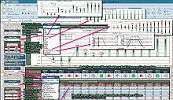 RF Cascade Workbook is the next phase in the evolution of RF Cafe's long-running
series, RF Cascade Workbook. Chances are you have never used a spreadsheet
quite like this (click
here for screen capture). It is a full-featured RF system cascade parameter
and frequency planner that includes filters and mixers for a mere $45. Built in
MS Excel, using RF Cascade Workbook is a cinch and the format
is entirely customizable. It is significantly easier and faster than using a multi-thousand
dollar simulator when a high level system analysis is all that is needed...
RF Cascade Workbook is the next phase in the evolution of RF Cafe's long-running
series, RF Cascade Workbook. Chances are you have never used a spreadsheet
quite like this (click
here for screen capture). It is a full-featured RF system cascade parameter
and frequency planner that includes filters and mixers for a mere $45. Built in
MS Excel, using RF Cascade Workbook is a cinch and the format
is entirely customizable. It is significantly easier and faster than using a multi-thousand
dollar simulator when a high level system analysis is all that is needed...
Wednesday the 27th
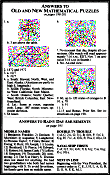 The first eight of these "Old
and New Mathematical Puzzles," which appeared in the 1989 edition of The Old
Farmer's Almanac, are fairly simple to figure out. None have a Difficulty rank of
greater than three. They also happen to be the only ones available, because I neglected
to scan the second page with problems 9 through 15 - and I cannot find the hard
copy. Oh well, the others would have been more trouble than they're worth for most
people. In all the years I have worked those problem sets, rarely did I bother putting
the thought required to solve the Difficulty 4 and Difficulty 5 challenges.
Admittedly, most were too baffling for me. I know some of you out there in the RF
Cafe audience can do them with the greatest of ease. Anyway, good luck to you on
these. The first eight of these "Old
and New Mathematical Puzzles," which appeared in the 1989 edition of The Old
Farmer's Almanac, are fairly simple to figure out. None have a Difficulty rank of
greater than three. They also happen to be the only ones available, because I neglected
to scan the second page with problems 9 through 15 - and I cannot find the hard
copy. Oh well, the others would have been more trouble than they're worth for most
people. In all the years I have worked those problem sets, rarely did I bother putting
the thought required to solve the Difficulty 4 and Difficulty 5 challenges.
Admittedly, most were too baffling for me. I know some of you out there in the RF
Cafe audience can do them with the greatest of ease. Anyway, good luck to you on
these.
 Exodus Advanced Communications, is a multinational
RF communication equipment and engineering service company serving both commercial
and government entities and their affiliates worldwide. We are pleased to present
the new Exodus
AMP2085E−1LC, a rugged quiet broadband class A/AB design for all industry applications.
Frequency 2.0-8.0 GHz, 250 W minimum, 300 W typical, 54dB gain, unprecedented
performance. Excellent power/gain flatness as compared to other amplifiers with
-20 dBc Harmonics. A perfect replacement for TWT systems. Forward/Reflected
power monitoring, VSWR, voltage/current/temperature sensing for superb reliability
and ruggedness. The nominal weight is 45 kg in a compact 7U chassis 12.25" H
x 19" W x 27" D... Exodus Advanced Communications, is a multinational
RF communication equipment and engineering service company serving both commercial
and government entities and their affiliates worldwide. We are pleased to present
the new Exodus
AMP2085E−1LC, a rugged quiet broadband class A/AB design for all industry applications.
Frequency 2.0-8.0 GHz, 250 W minimum, 300 W typical, 54dB gain, unprecedented
performance. Excellent power/gain flatness as compared to other amplifiers with
-20 dBc Harmonics. A perfect replacement for TWT systems. Forward/Reflected
power monitoring, VSWR, voltage/current/temperature sensing for superb reliability
and ruggedness. The nominal weight is 45 kg in a compact 7U chassis 12.25" H
x 19" W x 27" D...
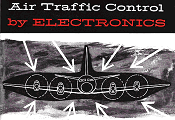 Air Route Traffic Control Centers, now using
the acronym ARTCC rather than ARTC as used in this 1960 article, were and still
are the human and computer command and control facilities responsible for safe and
orderly flow of air traffic in the U.S., and a worldwide network of Area Control
Center (ACC) handles everything else in a massive coordinated effort. The advent
of radar during World War II and the ensuing evolution of it and electronic
computers in the following years struggled to keep pace with the equally rapidly
evolving aircraft design and capability. A simple control tower with air traffic
controllers using binoculars and a radio mike could not handle the volume of airplanes
and helicopters traversing the skies and patronizing busy terminals. Many forms
of electronic navigation aids were developed including very high frequency omnidirectional
range (VOR), direction finders (DF) using antenna nulling for finding radials to/from
FM radio transmitter, long range navigation (LORAN), tactical air navigation (TACAN),
and others up through modern day satellite positioning systems (GPS, GLONASS, Galileo, BeiDou-2).
With the assistance of computers, radar systems got smarter with signal processing
able to differentiate between weather phenomena, moving aircraft, and stationary
ground clutter. Onboard transponders in aircraft in conjunction with ground-based
equipment provided a pseudo... Air Route Traffic Control Centers, now using
the acronym ARTCC rather than ARTC as used in this 1960 article, were and still
are the human and computer command and control facilities responsible for safe and
orderly flow of air traffic in the U.S., and a worldwide network of Area Control
Center (ACC) handles everything else in a massive coordinated effort. The advent
of radar during World War II and the ensuing evolution of it and electronic
computers in the following years struggled to keep pace with the equally rapidly
evolving aircraft design and capability. A simple control tower with air traffic
controllers using binoculars and a radio mike could not handle the volume of airplanes
and helicopters traversing the skies and patronizing busy terminals. Many forms
of electronic navigation aids were developed including very high frequency omnidirectional
range (VOR), direction finders (DF) using antenna nulling for finding radials to/from
FM radio transmitter, long range navigation (LORAN), tactical air navigation (TACAN),
and others up through modern day satellite positioning systems (GPS, GLONASS, Galileo, BeiDou-2).
With the assistance of computers, radar systems got smarter with signal processing
able to differentiate between weather phenomena, moving aircraft, and stationary
ground clutter. Onboard transponders in aircraft in conjunction with ground-based
equipment provided a pseudo...
 This being an engineering website, contemporary
instances of catastrophic failures of high tech objects and systems are fair game
for discussion. Having grown up just south of Baltimore, I crossed the Francis Scott
Key bridge many times. It opened for traffic the year (1977) after I graduated high
school. Conspiracy theories abound, but chances are it is a combination of human
and technical failure. I have these questions after
watching the
video: This being an engineering website, contemporary
instances of catastrophic failures of high tech objects and systems are fair game
for discussion. Having grown up just south of Baltimore, I crossed the Francis Scott
Key bridge many times. It opened for traffic the year (1977) after I graduated high
school. Conspiracy theories abound, but chances are it is a combination of human
and technical failure. I have these questions after
watching the
video:
- How can a modern container ship not have multiple redundant systems
to prevent a loss of navigation capability?
- Why wasn't the ship on a course
for the center of the span, allowing for tidal currents, so a loss of steering wouldn't
send it into a support pylon?
- No harbor radar system monitoring traffic a la
airports?
- Why wasn't "mayday" broadcast until a couple minutes before the collision?
- Where are reports from other vessels that watched it happen?
- How was such
a massive ship brought to a full stop just a few feet past the pylons?
- No radar
and sonar onboard with collision / avoidance warnings?
- Why hasn't Singapore
and/or India offered to pay for the damage and rebuilding?
- Why do Americans
have to pay for the aforementioned?
- Where are the photos of the ship's captain,
the harbor master, the Coast Guard and DOT people controlling that area?
I could
fill a page with such questions.
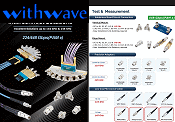 Withwave is a leading designer and developer
of a broad range of RF, microwave, and millimeter−wave test solutions and subsystems
with a focus on electromagnetic field analysis and signal processing. Our newly
released
High Speed & Microwave Interconnect Solutions provide a wide range of multiple
coax connectors and flexible cable assemblies with performance to 110 GHz based
on precision array design and superior high frequency cabling solutions. This includes
145 GHz capability Solderless Board Mount Connectors and cable assemblies for
224/448 Gbps (PAM x) systems. The WMX series is an excellent signal integrity
solution for bench-top and automated test equipment to meet increasing demands of
the semiconductor and optical test industries, including 5G communications and supercomputing.
Vertical mount and edge mount configurations available with 2.54 mm and 4.00 mm
connectors... Withwave is a leading designer and developer
of a broad range of RF, microwave, and millimeter−wave test solutions and subsystems
with a focus on electromagnetic field analysis and signal processing. Our newly
released
High Speed & Microwave Interconnect Solutions provide a wide range of multiple
coax connectors and flexible cable assemblies with performance to 110 GHz based
on precision array design and superior high frequency cabling solutions. This includes
145 GHz capability Solderless Board Mount Connectors and cable assemblies for
224/448 Gbps (PAM x) systems. The WMX series is an excellent signal integrity
solution for bench-top and automated test equipment to meet increasing demands of
the semiconductor and optical test industries, including 5G communications and supercomputing.
Vertical mount and edge mount configurations available with 2.54 mm and 4.00 mm
connectors...
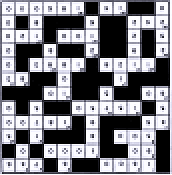 In many ways a
crossnumber (aka cross number or cross figure) puzzle, which is an intersecting
grid of numbers, is more challenging than a standard crossword puzzle, which is
an intersecting grid of letters. John Comstock created a few of these crossnumber
puzzles for Popular Electronics back in the early days of the magazine. If you have
never tried creating a crossword puzzle, especially one that uses only technical
terms and has many interconnected squares in the grid, then you cannot appreciate
the frustration it can be. The nice thing about creating a crossnumber puzzle versus
a crossword puzzle is that every number is a valid "word" and it is therefore never
a problem to find a clue to go with it. For example, any random number can be the
answer to a clue that expresses it as the series or parallel combination of resistances,
capacitances, or inductances... In many ways a
crossnumber (aka cross number or cross figure) puzzle, which is an intersecting
grid of numbers, is more challenging than a standard crossword puzzle, which is
an intersecting grid of letters. John Comstock created a few of these crossnumber
puzzles for Popular Electronics back in the early days of the magazine. If you have
never tried creating a crossword puzzle, especially one that uses only technical
terms and has many interconnected squares in the grid, then you cannot appreciate
the frustration it can be. The nice thing about creating a crossnumber puzzle versus
a crossword puzzle is that every number is a valid "word" and it is therefore never
a problem to find a clue to go with it. For example, any random number can be the
answer to a clue that expresses it as the series or parallel combination of resistances,
capacitances, or inductances...
Tuesday the 26th
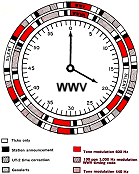 Greenbelt, Maryland, is not very far from
where I grew up just outside of Annapolis. One of the most recognizable technology
facilities residing there is NASA's Goddard Space Flight Center. One of the guys,
Mr. Dick Webber, in the Prince Georges Radio Control (PGRC) club to which I
belonged captured the FAI Closed Course Record with 225 miles flown in 5 hours and
38 minutes. My friend, Jerry Flynn, and I served as distance marker flagmen for
the feat (no skill involved on our part). Being close to both Washington, D.C.,
and the University of Maryland, there were many high tech operations in the area.
Since that time, new ones have come and others have gone. The National Bureau of
Standards' (NBS), now called the National Institute of Standards and Technology
(NIST), primary timekeeping facility, WWV, was located in Greenbelt until its move
to Fort Collins, Colorado, as reported in this 1967 issue of Radio-Electronics magazine.
BTW, I have also lived in Loveland, CO, just south of Ft. Collins. Maybe I'm naturally
drawn to WWV ;-) Greenbelt, Maryland, is not very far from
where I grew up just outside of Annapolis. One of the most recognizable technology
facilities residing there is NASA's Goddard Space Flight Center. One of the guys,
Mr. Dick Webber, in the Prince Georges Radio Control (PGRC) club to which I
belonged captured the FAI Closed Course Record with 225 miles flown in 5 hours and
38 minutes. My friend, Jerry Flynn, and I served as distance marker flagmen for
the feat (no skill involved on our part). Being close to both Washington, D.C.,
and the University of Maryland, there were many high tech operations in the area.
Since that time, new ones have come and others have gone. The National Bureau of
Standards' (NBS), now called the National Institute of Standards and Technology
(NIST), primary timekeeping facility, WWV, was located in Greenbelt until its move
to Fort Collins, Colorado, as reported in this 1967 issue of Radio-Electronics magazine.
BTW, I have also lived in Loveland, CO, just south of Ft. Collins. Maybe I'm naturally
drawn to WWV ;-)
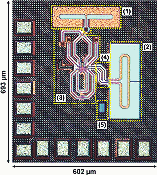 Seriously, someone should have wiped that
smashed spider off the die before the photo was taken ;-) "Researchers at the University
of Michigan have made what is in effect a very agile ruler using a novel
sub-THz radar technique, and reported it last week at the International Solid-State
Circuits Conference. Its 235 GHz antennas and the core active components are
integrated on a single IC, and across a desktop it measures the range to a target
with sub-mm accuracy, even if the object is moving at 600 m/s - twice the speed
of sound. These core components implement a 'self-injection-locking' oscillator,
which exploits the sometimes undesirable effect of oscillator 'pulling' where varying
the load on an oscillator alters its frequency. The oscillator in this case is a
differential second-harmonic Colpitts and it is attached to a slot antenna..." Seriously, someone should have wiped that
smashed spider off the die before the photo was taken ;-) "Researchers at the University
of Michigan have made what is in effect a very agile ruler using a novel
sub-THz radar technique, and reported it last week at the International Solid-State
Circuits Conference. Its 235 GHz antennas and the core active components are
integrated on a single IC, and across a desktop it measures the range to a target
with sub-mm accuracy, even if the object is moving at 600 m/s - twice the speed
of sound. These core components implement a 'self-injection-locking' oscillator,
which exploits the sometimes undesirable effect of oscillator 'pulling' where varying
the load on an oscillator alters its frequency. The oscillator in this case is a
differential second-harmonic Colpitts and it is attached to a slot antenna..."
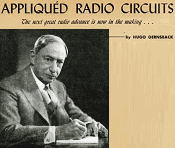 Proving once again what a visionary Hugo
Gernsback was regarding science and engineering, he published in his Radio-Craft
magazine this prognostication for the eventual supplanting of point-to-point wiring
with
printed circuit boards. Admittedly, by 1948 the electronics industry had begun
to outgrow hand-wired chassis assemblies with a rats nest of wires, components,
and terminal strips. It was in dire need of a new paradigm that reduced labor costs
and reduced the opportunity for wiring errors. Less than a year earlier the trio
of engineers at Bell Labs announced their transistor invention, so Mr. Gernsback
knew the world was about to change significantly. Bulky transformers, vacuum tubes,
and high voltage circuits would soon be relegated - at least in the consumer product
realm - to the newfangled television products, so miniaturization would follow quickly.
Even the smaller fingers of women on the assembly lines would have difficulty working
in such cramped spaces. Hugo Gernsback predicted both metallized circuit traces
and thick film "appliqued" traces on substrates... Proving once again what a visionary Hugo
Gernsback was regarding science and engineering, he published in his Radio-Craft
magazine this prognostication for the eventual supplanting of point-to-point wiring
with
printed circuit boards. Admittedly, by 1948 the electronics industry had begun
to outgrow hand-wired chassis assemblies with a rats nest of wires, components,
and terminal strips. It was in dire need of a new paradigm that reduced labor costs
and reduced the opportunity for wiring errors. Less than a year earlier the trio
of engineers at Bell Labs announced their transistor invention, so Mr. Gernsback
knew the world was about to change significantly. Bulky transformers, vacuum tubes,
and high voltage circuits would soon be relegated - at least in the consumer product
realm - to the newfangled television products, so miniaturization would follow quickly.
Even the smaller fingers of women on the assembly lines would have difficulty working
in such cramped spaces. Hugo Gernsback predicted both metallized circuit traces
and thick film "appliqued" traces on substrates...
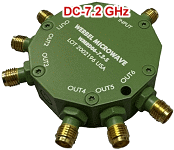 Werbel Microwave's WM6RD-7.2-S is a
6-way resistive power splitter / combiner that covers from DC to 7.2 GHz
with ultra-wide bandwidth. This unique design accomplishes extremely flat frequency
response in a small radial package. Our unique design approach provides higher than
expected isolation between outputs at far ports than would be achieved in a typical
star topology. It has applications in markets such as CATV, test and measurement,
and military radio. Its small size makes it easy to integrate into compact systems.
Designed, assembled, and tested in the USA... Werbel Microwave's WM6RD-7.2-S is a
6-way resistive power splitter / combiner that covers from DC to 7.2 GHz
with ultra-wide bandwidth. This unique design accomplishes extremely flat frequency
response in a small radial package. Our unique design approach provides higher than
expected isolation between outputs at far ports than would be achieved in a typical
star topology. It has applications in markets such as CATV, test and measurement,
and military radio. Its small size makes it easy to integrate into compact systems.
Designed, assembled, and tested in the USA...
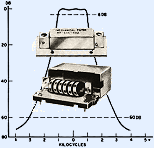 Restoring and/or upgrading
vintage radio receivers is still a very popular pastime for hobbyists, and for
that matter for some professional servicemen who preform maintenance on established
equipment installations. Three of the most significant changes that can be made
to older receivers to improve sensitivity are to clean up the power supply DC output,
replace noisy components like vacuum tubes and leaky capacitors, and tune / modify
/ replace RF and IF filters. This 1965 Popular Electronics magazine article
discusses a method of replacing a stock LC filter with a high selectivity mechanical
filter. The nice thing about an analog receiver is that narrowband, steep-skirt
filters can be substituted without concern for group delay at the band edges that
can (and will) wreak havoc on digital signals... Restoring and/or upgrading
vintage radio receivers is still a very popular pastime for hobbyists, and for
that matter for some professional servicemen who preform maintenance on established
equipment installations. Three of the most significant changes that can be made
to older receivers to improve sensitivity are to clean up the power supply DC output,
replace noisy components like vacuum tubes and leaky capacitors, and tune / modify
/ replace RF and IF filters. This 1965 Popular Electronics magazine article
discusses a method of replacing a stock LC filter with a high selectivity mechanical
filter. The nice thing about an analog receiver is that narrowband, steep-skirt
filters can be substituted without concern for group delay at the band edges that
can (and will) wreak havoc on digital signals...
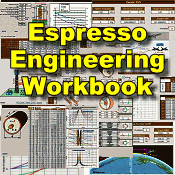 The newest release of RF Cafe's spreadsheet
(Excel) based engineering and science calculator is now available -
Espresso Engineering Workbook™. Among other additions, it now has a Butterworth
Bandpass Calculator, and a Highpass Filter Calculator that does not just gain, but
also phase and group delay! Since 2002,
the original Calculator Workbook has been available as a free download.
Continuing the tradition, RF Cafe Espresso Engineering Workbook™ is
also provided at no cost,
compliments of my generous sponsors. The original calculators are included, but
with a vastly expanded and improved user interface. Error-trapped user input cells
help prevent entry of invalid values. An extensive use of Visual Basic for Applications
(VBA) functions now do most of the heavy lifting with calculations, and facilitates
a wide user-selectable choice of units for voltage, frequency, speed, temperature,
power, wavelength, weight, etc. In fact, a full page of units conversion calculators
is included. A particularly handy feature is the ability to specify the the number
of significant digits to display. Drop-down menus are provided for convenience... The newest release of RF Cafe's spreadsheet
(Excel) based engineering and science calculator is now available -
Espresso Engineering Workbook™. Among other additions, it now has a Butterworth
Bandpass Calculator, and a Highpass Filter Calculator that does not just gain, but
also phase and group delay! Since 2002,
the original Calculator Workbook has been available as a free download.
Continuing the tradition, RF Cafe Espresso Engineering Workbook™ is
also provided at no cost,
compliments of my generous sponsors. The original calculators are included, but
with a vastly expanded and improved user interface. Error-trapped user input cells
help prevent entry of invalid values. An extensive use of Visual Basic for Applications
(VBA) functions now do most of the heavy lifting with calculations, and facilitates
a wide user-selectable choice of units for voltage, frequency, speed, temperature,
power, wavelength, weight, etc. In fact, a full page of units conversion calculators
is included. A particularly handy feature is the ability to specify the the number
of significant digits to display. Drop-down menus are provided for convenience...
Monday the 25th
I saw this posted on a website today:
The other day while sitting in my car I accidently put my cellphone into "Airplane
Mode." Shortly after getting underway, the door fell off.
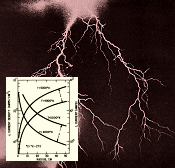 "A typical
discharge of lightning releases nearly 100 million volts along its path - through
which as much as 250,000 amps of current flows. Temperatures reach 30,000°C, roughly
five times the surface temperature of the sun. The stroke lasts only a few milliseconds,
so the average power is low-typically from 10 to 100 watts." Let's see... 100 MV
x 250 kA = 25,000 gigawatts (Doc Brown's DeLorean only needed 1.21 GW).
Over 1 ms that's an energy of 25 gigajoules. I'm not sure where the 10
to 100 watts of "average" power in the article comes from. The National Weather
Service says, "A typical lightning flash is about 300 million volts and about 30,000
amps." That's 9,000 gigawatts, enough for 7,438 time travel trips. ...but I digress.
The April 1967 issue of Radio−Electronics magazine had a cover announcement
of "Lightning and UFO's." This is the article to which it refers. "A typical
discharge of lightning releases nearly 100 million volts along its path - through
which as much as 250,000 amps of current flows. Temperatures reach 30,000°C, roughly
five times the surface temperature of the sun. The stroke lasts only a few milliseconds,
so the average power is low-typically from 10 to 100 watts." Let's see... 100 MV
x 250 kA = 25,000 gigawatts (Doc Brown's DeLorean only needed 1.21 GW).
Over 1 ms that's an energy of 25 gigajoules. I'm not sure where the 10
to 100 watts of "average" power in the article comes from. The National Weather
Service says, "A typical lightning flash is about 300 million volts and about 30,000
amps." That's 9,000 gigawatts, enough for 7,438 time travel trips. ...but I digress.
The April 1967 issue of Radio−Electronics magazine had a cover announcement
of "Lightning and UFO's." This is the article to which it refers.
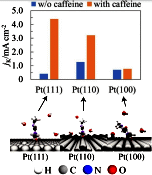 Not mentioned in the story is that the discovery
was probably made as the result of a scientist accidentally spilling his coffee
into the battery. "Researchers have realized an
11 times increase in a fuel cell's oxygen reduction reaction by adding caffeine
to the electrodes. According to the team from Chiba University, Japan, the addition
of caffeine can enhance the efficiency of the fuel cell, reduce the requirement
for excess platinum catalysts, and lead to cheaper and more efficient fuel cells.
In a hydrogen fuel cell, hydrogen undergoes oxidation at the anode, producing hydrogen
ions and electrons. The ions move through the electrolyte to the cathode, and electrons
flow through an external circuit, generating electricity. At the cathode, oxygen
combines with the hydrogen ions and electrons, resulting in water as a by-product.
The water reacts with the platinum (Pt) catalyst, forming a layer of platinum hydroxide
(PtOH) on the electrode, which obstructs the efficient catalysis of the oxygen reduction
reaction (ORR)..." Not mentioned in the story is that the discovery
was probably made as the result of a scientist accidentally spilling his coffee
into the battery. "Researchers have realized an
11 times increase in a fuel cell's oxygen reduction reaction by adding caffeine
to the electrodes. According to the team from Chiba University, Japan, the addition
of caffeine can enhance the efficiency of the fuel cell, reduce the requirement
for excess platinum catalysts, and lead to cheaper and more efficient fuel cells.
In a hydrogen fuel cell, hydrogen undergoes oxidation at the anode, producing hydrogen
ions and electrons. The ions move through the electrolyte to the cathode, and electrons
flow through an external circuit, generating electricity. At the cathode, oxygen
combines with the hydrogen ions and electrons, resulting in water as a by-product.
The water reacts with the platinum (Pt) catalyst, forming a layer of platinum hydroxide
(PtOH) on the electrode, which obstructs the efficient catalysis of the oxygen reduction
reaction (ORR)..."
 Steerable phased array antenna systems used
to be the exclusive domain of military and aerospace radar and electronics warfare
systems. The expense involved in both the hardware (structure, antenna elements,
electric power, cooling) and the electronics required for controlling the beam was
expensive and complicated. Larger phased array antennas for lower frequency (longer
wavelength) bands are still relatively expensive. However, small cell wireless phone
and WiFi applications in the 2.4 GHz and higher bands are seeing the development
and deployment of phased arrays that will search for and track individual users
in order to allocate antenna gain and signal power where it is needed, rather than
using an omnidirectional radiation pattern. Physically steered directional antennas
are not capable of the speeds needed to do the job. In the last couple years, MMIC
phased antenna arrays have begun appearing in the news for millimeter-wave systems.
Construction of PAVE PAWS (Precision Acquisition Vehicle Entry Phased Array Warning
System, AN/FPS-115) location... Steerable phased array antenna systems used
to be the exclusive domain of military and aerospace radar and electronics warfare
systems. The expense involved in both the hardware (structure, antenna elements,
electric power, cooling) and the electronics required for controlling the beam was
expensive and complicated. Larger phased array antennas for lower frequency (longer
wavelength) bands are still relatively expensive. However, small cell wireless phone
and WiFi applications in the 2.4 GHz and higher bands are seeing the development
and deployment of phased arrays that will search for and track individual users
in order to allocate antenna gain and signal power where it is needed, rather than
using an omnidirectional radiation pattern. Physically steered directional antennas
are not capable of the speeds needed to do the job. In the last couple years, MMIC
phased antenna arrays have begun appearing in the news for millimeter-wave systems.
Construction of PAVE PAWS (Precision Acquisition Vehicle Entry Phased Array Warning
System, AN/FPS-115) location...
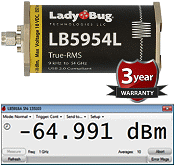 LadyBug Technologies' new LB5954L is a high
accuracy, platform independent RF & Microwave Power Sensor for general purpose
average power or True RMS and scalar measurements. This
True RMS Average Power Sensor+™ with Triggering 9 kHz to 54 GHz features
exceptionally fast measurement speed, a broad dynamic range, and the widest set
of options for programmatic and embedded applications in the industry. LadyBug's
feature rich Power Meter Application is provided with each sensor. Time domain trace
visibility is included and aids in setting markers. The sensor is useful in research &
development, manufacturing & service applications including radar, satellite
and telecommunications. Recommended for average power measurements on signals with
any modulation type including: 802.11ac, GSM, CDMA 2000, CDMA (IS-95), TDMA, Multi-Tone,
OFDM, CW, QAM and more... LadyBug Technologies' new LB5954L is a high
accuracy, platform independent RF & Microwave Power Sensor for general purpose
average power or True RMS and scalar measurements. This
True RMS Average Power Sensor+™ with Triggering 9 kHz to 54 GHz features
exceptionally fast measurement speed, a broad dynamic range, and the widest set
of options for programmatic and embedded applications in the industry. LadyBug's
feature rich Power Meter Application is provided with each sensor. Time domain trace
visibility is included and aids in setting markers. The sensor is useful in research &
development, manufacturing & service applications including radar, satellite
and telecommunications. Recommended for average power measurements on signals with
any modulation type including: 802.11ac, GSM, CDMA 2000, CDMA (IS-95), TDMA, Multi-Tone,
OFDM, CW, QAM and more...
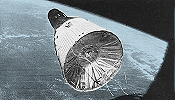 When I originally tagged this Electronics
magazine article for posting, it was before Golden State Warriors guard Stephen
Curry tapped into his immense cerebral power to inform us all that NASA has been
faking its accomplishments in space - notably all the moon landings. Now, based
on such unimpeachable authority, I'm not so sure this story should even be posted,
lest it potentially perpetuate a long-running ruse. In the manner of contemporary
news pieces reporting on criminal activity while avoiding legal claims of libel
or character assassination, please mentally preface all of the claims herein with
"alleged" or "allegedly." The world's first successful spacecraft rendezvous,
accomplished by
Gemini 6 and Gemini 7, happened on December 15, 1965. Both astronaut
crews participated in many communications experiments that included radio, visual,
and laser media... When I originally tagged this Electronics
magazine article for posting, it was before Golden State Warriors guard Stephen
Curry tapped into his immense cerebral power to inform us all that NASA has been
faking its accomplishments in space - notably all the moon landings. Now, based
on such unimpeachable authority, I'm not so sure this story should even be posted,
lest it potentially perpetuate a long-running ruse. In the manner of contemporary
news pieces reporting on criminal activity while avoiding legal claims of libel
or character assassination, please mentally preface all of the claims herein with
"alleged" or "allegedly." The world's first successful spacecraft rendezvous,
accomplished by
Gemini 6 and Gemini 7, happened on December 15, 1965. Both astronaut
crews participated in many communications experiments that included radio, visual,
and laser media...
 Banner Ads are rotated in all locations
on the page! RF Cafe typically receives 8,000-15,000 visits each
weekday. RF Cafe
is a favorite of engineers, technicians, hobbyists, and students all over the world.
With more than 17,000 pages in the Google search index, RF Cafe returns in
favorable positions on many types of key searches, both for text and images.
Your Banner Ads are displayed on average 280,000 times per year! New content
is added on a daily basis, which keeps the major search engines interested enough
to spider it multiple times each day. Items added on the homepage often can be found
in a Google search within a few hours of being posted. If you need your company
news to be seen, RF Cafe is the place to be... Banner Ads are rotated in all locations
on the page! RF Cafe typically receives 8,000-15,000 visits each
weekday. RF Cafe
is a favorite of engineers, technicians, hobbyists, and students all over the world.
With more than 17,000 pages in the Google search index, RF Cafe returns in
favorable positions on many types of key searches, both for text and images.
Your Banner Ads are displayed on average 280,000 times per year! New content
is added on a daily basis, which keeps the major search engines interested enough
to spider it multiple times each day. Items added on the homepage often can be found
in a Google search within a few hours of being posted. If you need your company
news to be seen, RF Cafe is the place to be...
Friday the 22nd
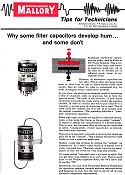 Here is something you might not have known
about electrolytic capacitors. I'm guessing the issue has been mitigated in modern
capacitors, but in 1962 when this "Tips for Technicians" infomercial was published
in Radio−Electronics magazine, an electrochemical mechanism could occur
in
electrolytic capacitors which reduced the effective capacitance by creating
the equivalent of two or more capacitors in series. Capacitors in series combine
like resistors in parallel, reducing the equivalent value. It is impressive that
the scientists / chemists / engineers at Mallory were able to figure out what was
causing electrolytic capacitors to decrease in value over time. This is the kind
of thing that might show up in a Mac's Service Shop episode. Read on to find out
what was going on... Here is something you might not have known
about electrolytic capacitors. I'm guessing the issue has been mitigated in modern
capacitors, but in 1962 when this "Tips for Technicians" infomercial was published
in Radio−Electronics magazine, an electrochemical mechanism could occur
in
electrolytic capacitors which reduced the effective capacitance by creating
the equivalent of two or more capacitors in series. Capacitors in series combine
like resistors in parallel, reducing the equivalent value. It is impressive that
the scientists / chemists / engineers at Mallory were able to figure out what was
causing electrolytic capacitors to decrease in value over time. This is the kind
of thing that might show up in a Mac's Service Shop episode. Read on to find out
what was going on...
 The
subtitle reads thusly: "Innovative Design of the FCC's Historic Broadcast Incentive
Auction Brought Benefits to Broadcasters, Wireless Carriers, Consumers, and Taxpayers.
Maybe it's just me, but this smells like a back room payoff to Federal Communications
Commission staffers in order to curry favor in regulatory decisions - a quid pro
quo in the making. Government employees are not allowed to accepts gifts. "The
Federal Communications Commission today announced that it has been awarded a
Technology &
Engineering Emmy® Award by the National Academy of Television Arts & Sciences.
The Academy announced that it has bestowed the award for the creativity and engineering
design of the FCC's Broadcast Incentive Auction. The Broadcast Incentive Auction
was a years-long project that allowed over-the-air TV stations to return underutilized
broadcast spectrum in return for incentive payments. The innovative auction design
included channel sharing..." The
subtitle reads thusly: "Innovative Design of the FCC's Historic Broadcast Incentive
Auction Brought Benefits to Broadcasters, Wireless Carriers, Consumers, and Taxpayers.
Maybe it's just me, but this smells like a back room payoff to Federal Communications
Commission staffers in order to curry favor in regulatory decisions - a quid pro
quo in the making. Government employees are not allowed to accepts gifts. "The
Federal Communications Commission today announced that it has been awarded a
Technology &
Engineering Emmy® Award by the National Academy of Television Arts & Sciences.
The Academy announced that it has bestowed the award for the creativity and engineering
design of the FCC's Broadcast Incentive Auction. The Broadcast Incentive Auction
was a years-long project that allowed over-the-air TV stations to return underutilized
broadcast spectrum in return for incentive payments. The innovative auction design
included channel sharing..."
 Channel Master has been making state-of-the-art
television antennas since 1949. Back in the day, there were many TV antenna
manufacturers because over-the-air (OTA) broadcasts were the only means of receiving
programs. The advent of cable, satellite, and Internet television has caused a steady
decline of OTA users even though most locations still broadcast from towers. It
is a shame because aside from the more on-demand aspect of some of those other venues,
Channel Master notes: "Live Broadcast Television - It's 80% of what you watch. And
it's free." The wireless adoption mantra de jour of "Cut the Cord" can be applied
to TV and save you some money if you can do without that other 20%. In this episode,
Mac explains the advanced engineering that went into designing the CM Quantum Model
1160 antenna. Fourier transforms and tapered current in the driven and reflector
elements were key to the development, along with much empirical testing and adjusting.
Most antennas today are designed with sophisticated electromagnetic simulation software
that usually result in first-pass success. Optimizer parameters are set for initial
configurations and the the computers do the rest. That goes for both electrical
and mechanical performance... Channel Master has been making state-of-the-art
television antennas since 1949. Back in the day, there were many TV antenna
manufacturers because over-the-air (OTA) broadcasts were the only means of receiving
programs. The advent of cable, satellite, and Internet television has caused a steady
decline of OTA users even though most locations still broadcast from towers. It
is a shame because aside from the more on-demand aspect of some of those other venues,
Channel Master notes: "Live Broadcast Television - It's 80% of what you watch. And
it's free." The wireless adoption mantra de jour of "Cut the Cord" can be applied
to TV and save you some money if you can do without that other 20%. In this episode,
Mac explains the advanced engineering that went into designing the CM Quantum Model
1160 antenna. Fourier transforms and tapered current in the driven and reflector
elements were key to the development, along with much empirical testing and adjusting.
Most antennas today are designed with sophisticated electromagnetic simulation software
that usually result in first-pass success. Optimizer parameters are set for initial
configurations and the the computers do the rest. That goes for both electrical
and mechanical performance...
 Sam Benzacar of Anatech Electronics, an
RF and microwave filter company, has published his March 2024 newsletter that, along
with timely news items, features his short op−ed entitled "5G
Broadcast is Finally Coming," where he reports on the progress recently made
in fulfilling plans finalized in the 2017 in 3GPP Release 14. "In a nutshell, 5G
Broadcast makes it possible to deliver high-bandwidth content to a massive audience
concurrently without compromising network performance." The whole 5G scheme is to
have the capacity to completely replace wired communications with wireless. That
involves two-way data transfers in the Gbps realm. My cable Internet connection
is providing a download speed of 590 Mbps and upload of 25 Mbps (upload
speeds are severely throttled for some reason), per SpeedTest.net. Using a cellphone
as a mobile hotspot, I get around 22 Mbps down and 12 Mbps up. Those numbers
are dependent upon when you happen to measure it, but I know they are typical of
what I see. That represents a wired connection 22x faster than wireless, but then
my Galaxy S7 is not the best platform to measure wireless performance. Finally,
with 5G, people can watch an 8K UHD feature length movie on their phones while sitting
in the stands at a ball game or in a movie theater... Sam Benzacar of Anatech Electronics, an
RF and microwave filter company, has published his March 2024 newsletter that, along
with timely news items, features his short op−ed entitled "5G
Broadcast is Finally Coming," where he reports on the progress recently made
in fulfilling plans finalized in the 2017 in 3GPP Release 14. "In a nutshell, 5G
Broadcast makes it possible to deliver high-bandwidth content to a massive audience
concurrently without compromising network performance." The whole 5G scheme is to
have the capacity to completely replace wired communications with wireless. That
involves two-way data transfers in the Gbps realm. My cable Internet connection
is providing a download speed of 590 Mbps and upload of 25 Mbps (upload
speeds are severely throttled for some reason), per SpeedTest.net. Using a cellphone
as a mobile hotspot, I get around 22 Mbps down and 12 Mbps up. Those numbers
are dependent upon when you happen to measure it, but I know they are typical of
what I see. That represents a wired connection 22x faster than wireless, but then
my Galaxy S7 is not the best platform to measure wireless performance. Finally,
with 5G, people can watch an 8K UHD feature length movie on their phones while sitting
in the stands at a ball game or in a movie theater...
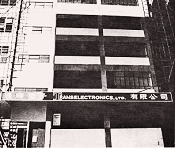 Pardon my gallows humor, but when I first
saw this photo from a 1965 issue of Electronics magazine of this manufacturing
plant being built in Hong Kong, my thought was that maybe those scaffolds in front
of the windows were actually there to prevent despondent, hopeless employees from
jumping onto the sidewalks below. These days, more stylish and socially acceptable
nets are used. The take-away from this story is that while it might seem the shifting
of manufacturing to and/or sourcing of
foreign-made products by U.S. firms from China is not a recent phenomenon. This
was half a century ago before the fall of the Berlin Wall, before the breakup of
the U.S.S.R., the mowing down of student protestors in Tiananmen Square, and other
high profile partial breakdowns of Iron Curtain communist regimes. Taiwan was already
exporting electronics to the West. Zenith manufactured U.S.-designed TV's in China
and Fairchild produced silicon transistors there. A deep dive into the history of
electronics and other consumer product manufacturing and export from China would
no doubt turn up a sizeable list of familiar company names... Pardon my gallows humor, but when I first
saw this photo from a 1965 issue of Electronics magazine of this manufacturing
plant being built in Hong Kong, my thought was that maybe those scaffolds in front
of the windows were actually there to prevent despondent, hopeless employees from
jumping onto the sidewalks below. These days, more stylish and socially acceptable
nets are used. The take-away from this story is that while it might seem the shifting
of manufacturing to and/or sourcing of
foreign-made products by U.S. firms from China is not a recent phenomenon. This
was half a century ago before the fall of the Berlin Wall, before the breakup of
the U.S.S.R., the mowing down of student protestors in Tiananmen Square, and other
high profile partial breakdowns of Iron Curtain communist regimes. Taiwan was already
exporting electronics to the West. Zenith manufactured U.S.-designed TV's in China
and Fairchild produced silicon transistors there. A deep dive into the history of
electronics and other consumer product manufacturing and export from China would
no doubt turn up a sizeable list of familiar company names...
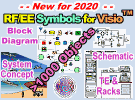 With more than 1000
custom-built symbols, this has got to be the most comprehensive set of
Visio Symbols
available for RF, analog, and digital system and schematic drawings! Every object
has been built to fit proportionally on the provided A-, B- and C-size drawing page
templates (or can use your own). Symbols are provided for equipment racks and test
equipment, system block diagrams, conceptual drawings, and schematics. Unlike previous
versions, these are NOT Stencils, but instead are all contained on tabbed pages
within a single Visio document. That puts everything in front of you in its full
glory. Just copy and paste what you need on your drawing... With more than 1000
custom-built symbols, this has got to be the most comprehensive set of
Visio Symbols
available for RF, analog, and digital system and schematic drawings! Every object
has been built to fit proportionally on the provided A-, B- and C-size drawing page
templates (or can use your own). Symbols are provided for equipment racks and test
equipment, system block diagrams, conceptual drawings, and schematics. Unlike previous
versions, these are NOT Stencils, but instead are all contained on tabbed pages
within a single Visio document. That puts everything in front of you in its full
glory. Just copy and paste what you need on your drawing...
These archive pages are provided in order to make it easier for you to find items
that you remember seeing on the RF Cafe homepage. Of course probably the easiest
way to find anything on the website is to use the "Search
RF Cafe" box at the top of every page.
About RF Cafe.
Homepage Archive Pages
2024:
Jan |
Feb |
Mar |
Apr |
May |
Jun |
Jul |
Aug |
Sep |
Oct |
Nov |
Dec
2023:
Jan |
Feb |
Mar |
Apr |
May |
Jun |
Jul |
Aug |
Sep |
Oct |
Nov |
Dec
2022:
Jan |
Feb |
Mar |
Apr |
May |
Jun |
Jul |
Aug |
Sep |
Oct |
Nov |
Dec
2021:
Jan |
Feb |
Mar |
Apr |
May |
Jun |
Jul |
Aug |
Sep |
Oct |
Nov |
Dec
2020:
Jan |
Feb |
Mar |
Apr |
May |
Jun |
Jul |
Aug |
Sep |
Oct |
Nov |
Dec
2019:
Jan |
Feb |
Mar |
Apr |
May |
Jun |
Jul |
Aug |
Sep |
Oct |
Nov |
Dec
2018:
Jan |
Feb |
Mar |
Apr |
May |
Jun |
Jul |
Aug |
Sep |
Oct |
Nov |
Dec
2017:
Jan | Feb |
Mar |
Apr |
May |
Jun |
Jul |
Aug |
Sep |
Oct |
Nov |
Dec
2016:
Jan |
Feb |
Mar |
Apr |
May |
Jun |
Jul |
Aug |
Sep |
Oct |
Nov |
Dec
2015:
Jan |
Feb |
Mar |
Apr |
May |
Jun |
Jul |
Aug |
Sep |
Oct |
Nov |
Dec
2014:
Jan |
Feb |
Mar |
Apr |
May |
Jun |
Jul |
Aug |
Sep |
Oct |
Nov |
Dec
2013:
Jan |
Feb |
Mar |
Apr |
May |
Jun |
Jul |
Aug |
Sep |
Oct |
Nov |
Dec
2012:
1 |
2 |
3 |
4 |
5 |
6 |
7 |
8 |
9 |
10 |
11 |
12 |
13 (no archives before 2012)
|













 Air Route Traffic Control Centers
Air Route Traffic Control Centers










 Steerable phased array antenna systems
Steerable phased array antenna systems







